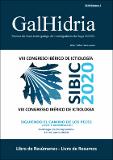Por favor, use este identificador para citar o enlazar a este item:
http://hdl.handle.net/10261/233529COMPARTIR / EXPORTAR:
 SHARE
BASE SHARE
BASE
|
|
| Visualizar otros formatos: MARC | Dublin Core | RDF | ORE | MODS | METS | DIDL | DATACITE | |

| Título: | Molecular and functional characterisation of fads2 in grass carp (Ctenopharyngodon idella) |
Autor: | Marrero, M.; Monroig, Óscar CSIC ORCID; Navarro, Juan Carlos CSIC ORCID ; Ribes-Navarro, Alberto CSIC ORCID; Galindo, A.; Rodríguez, Covadonga | Fecha de publicación: | 15-jun-2020 | Citación: | VIII Congreso Ibérico de Ictiología (2020) | Resumen: | Long-chain (≥C20) polyunsaturated fatty acids (LC-PUFAs) are essential nutrients involved in critical biological activities with different structural, functional and signalling roles. Indeed, dietary LC-PUFAs levels are especially relevant in human health and have several implications in many diseases processes. Therefore, it is a topic of interest knowing the mechanisms that regulate LC- PUFA biosynthesis in aquaculture species. The LC-PUFA biosynthesis pathway in fishes involves sequential desaturation and elongation steps from C18 PUFA substrates catalysed by fatty acyl desaturase (Fads) and elongation of very long chain fatty acids (Elovl) proteins. In particular, the fatty acyl desaturases 2 (Fads2) is a key enzyme that catalyses the introduction of double bonds into fatty acids. The aim of this work is the molecular and functional characterisation of fads2 gene in the grass carp (Ctenopharyngodon idella), an herbivorous freshwater fish with a high market value and reputation in China for its meat quality. Thus, the coding sequence (CDS) of putative Fads2 was isolated from the grass carp and was functionally characterised by heterologous expression in yeast (Saccharomyces cerevisiae). The open reading frame (ORF) of the grass carp consisted of 1332 bp that codifies a protein of 444 amino acids. For functional characterisation, transgenic yeast expressing the C. idella fads2 desaturase were grown in the presence of ∆6 (18:2n–6, 18:3n–3 and 24:5n-3), ∆8 (20:2n–6 and 20:3n–3), ∆5 (20:4n–3 and 20:3n–6) and ∆4 (22:5n–3 and 22:4n– 6) substrates. Our results showed that C. idella Fads2 has ∆5/∆6/∆8 activity, catalysing all the desaturation reactions required for arachidonic acid (20:4n-6) and eicosapentaenoic acid (20:5n- 3) biosynthesis from C18 precursors. Furthermore, the C. idella Fads2 enzyme also desaturated 24:5n-3 to 24:6n-3, a ∆6 desaturation reaction required for the biosynthesis of docosahexaenoic acid (22:6n-3) through the so-called “Sprecher pathway”. | Descripción: | Resumen del trabajo presentado en el VIII Congreso Ibérico de Ictiología, celebrado en Santiago de Compostela (España) del 15 al 19 de junio de 2020. | URI: | http://hdl.handle.net/10261/233529 |
| Aparece en las colecciones: | (IATS) Comunicaciones congresos |
Ficheros en este ítem:
| Fichero | Descripción | Tamaño | Formato | |
|---|---|---|---|---|
| Molecular_Marrero_ComCong2020.pdf | 937,28 kB | Adobe PDF |  Visualizar/Abrir |
CORE Recommender
Page view(s)
134
checked on 23-abr-2024
Download(s)
49
checked on 23-abr-2024
Google ScholarTM
Check
NOTA: Los ítems de Digital.CSIC están protegidos por copyright, con todos los derechos reservados, a menos que se indique lo contrario.
